Intel Haswell-EP Xeon 12 Core Review: E5-2650L V3 and E5-2690 V3
by Ian Cutress on November 6, 2014 9:00 AM EST- Posted in
- CPUs
- IT Computing
- Intel
- Xeon
- Enterprise
- LGA2011-3
- Haswell EP
Gaming Benchmarks
While the last thought on the minds of most Xeon users is related to gaming, we frequently get requests to test gaming performance on Xeons. As a result we strap the Xeon to a regular consumer level motherboard that can support them and add in one or two GPUs to see how they perform and if more cores makes a difference over the drop in frequency. Unfortunately due to the orientation of the PCIe slots on the 2P board, we were unable to test the dual E5-2650L v3 configuration.
F1 2013
First up is F1 2013 by Codemasters. I am a big Formula 1 fan in my spare time, and nothing makes me happier than carving up the field in a Caterham, waving to the Red Bulls as I drive by (because I play on easy and take shortcuts). F1 2013 uses the EGO Engine, and like other Codemasters games ends up being very playable on old hardware quite easily. In order to beef up the benchmark a bit, we devised the following scenario for the benchmark mode: one lap of Spa-Francorchamps in the heavy wet, the benchmark follows Jenson Button in the McLaren who starts on the grid in 22nd place, with the field made up of 11 Williams cars, 5 Marussia and 5 Caterham in that order. This puts emphasis on the CPU to handle the AI in the wet, and allows for a good amount of overtaking during the automated benchmark. We test at 1920x1080 on Ultra graphical settings.
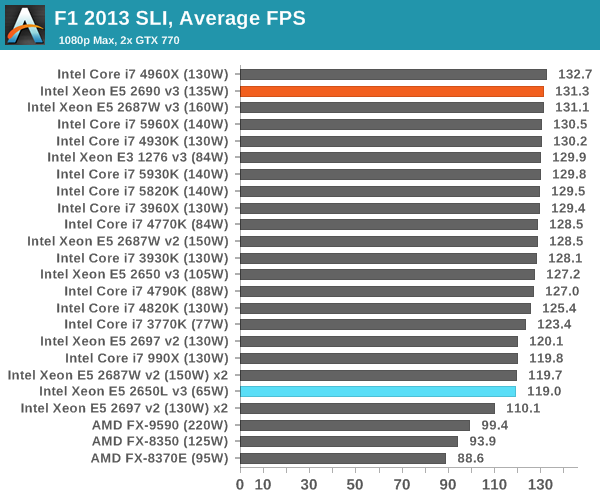
Bioshock Infinite
Bioshock Infinite was Zero Punctuation’s Game of the Year for 2013, uses the Unreal Engine 3, and is designed to scale with both cores and graphical prowess. We test the benchmark using the Adrenaline benchmark tool and the Xtreme (1920x1080, Maximum) performance setting, noting down the average frame rates and the minimum frame rates.
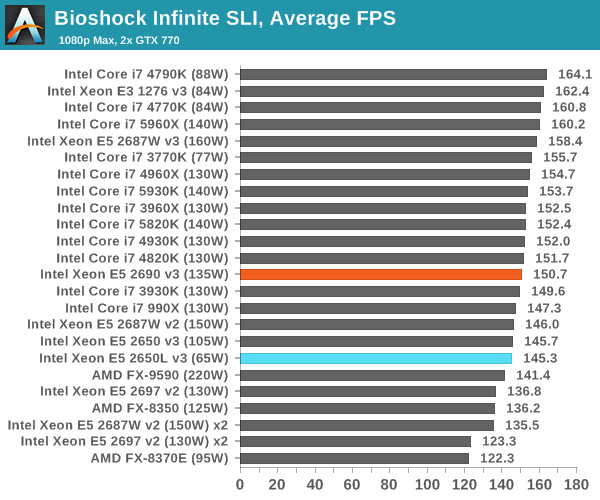
Tomb Raider
The next benchmark in our test is Tomb Raider. Tomb Raider is an AMD optimized game, lauded for its use of TressFX creating dynamic hair to increase the immersion in game. Tomb Raider uses a modified version of the Crystal Engine, and enjoys raw horsepower. We test the benchmark using the Adrenaline benchmark tool and the Xtreme (1920x1080, Maximum) performance setting, noting down the average frame rates and the minimum frame rates.
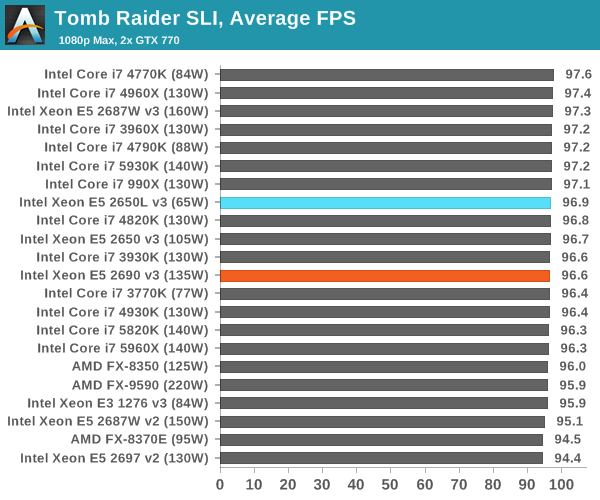
Sleeping Dogs
Sleeping Dogs is a benchmarking wet dream – a highly complex benchmark that can bring the toughest setup and high resolutions down into single figures. Having an extreme SSAO setting can do that, but at the right settings Sleeping Dogs is highly playable and enjoyable. We run the basic benchmark program laid out in the Adrenaline benchmark tool, and the Xtreme (1920x1080, Maximum) performance setting, noting down the average frame rates and the minimum frame rates.
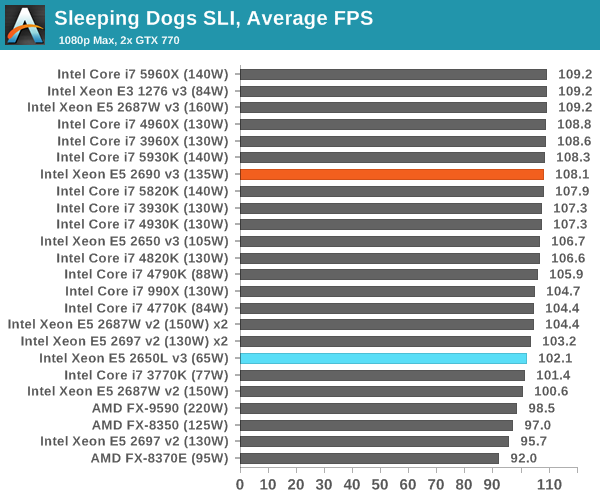
Battlefield 4
The EA/DICE series that has taken countless hours of my life away is back for another iteration, using the Frostbite 3 engine. AMD is also piling its resources into BF4 with the new Mantle API for developers, designed to cut the time required for the CPU to dispatch commands to the graphical sub-system. For our test we use the in-game benchmarking tools and record the frame time for the first ~70 seconds of the Tashgar single player mission, which is an on-rails generation of and rendering of objects and textures. We test at 1920x1080 at Ultra settings.
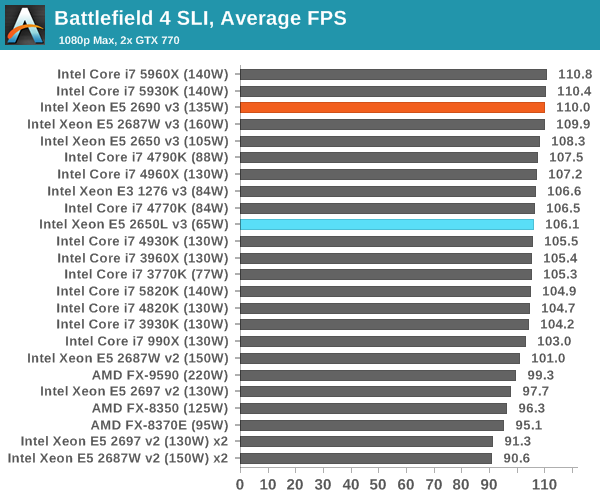















52 Comments
View All Comments
SanX - Thursday, November 6, 2014 - link
All that is secondary to production cost. Trying to emphasize that the production cost of Intel chips is barely 30-50 bucks at the most. Probably much less since those mibile chips still get the profit. Some 4 core mobile chips with 1 billion transistors are already sold for 4 dollars and still bring the profitDeath666Angel - Sunday, November 9, 2014 - link
Those guys do not invest anything in R&D and the chips are much smaller due to less complex cores and uncore areas.dragonsqrrl - Thursday, November 6, 2014 - link
Trollololololruthan - Thursday, November 6, 2014 - link
Very great article theme, i can complain about some particular things in article, but in general im really grateful that such article exist at all.ruthan - Thursday, November 6, 2014 - link
To results, i would like to see comparison 65W Xeon with Core i7 architecture -65W model - 4590S head to head.In comparison Core i7 3770k - for 320$ and this 1320$ is 1000 bucks for what?
+ 25% of performance in most of multi threaded benchmarks and - 5% in gaming and generally limited mainboard choice and + for ECC memory.
If there would be +50% in multithreaded apps i would consider Xeon for my workstation, otherwise it does make no sense. 12 weak cores is nothing to be excited, or my good for some web, DB server, or visualization - here im still curious about results.
LeptonX - Thursday, November 6, 2014 - link
Something wrong with the results they seem inconsistent, why doesn't 2687W v3 mop the floor with 5960X? By all means it should as it have both more cores and more cache, yet it loses to the i7 by a quite significant margin sometimes. Is that the result of using the bigger die which is quite different in cores arrangement and also have bigger but slower cache. Still, I think it should win practically everywhere and yet it even manages to loses to its predecessor(2687 V2) in Linux-Bench NPD FD and the margin of victory of 5960X is strangely high. Were they tested in different motherboards or even with MCE enabled on 5960X and disabled on 2687W V3? How can you explain those results?Ytterbium - Friday, November 7, 2014 - link
MCE doesn't work with Xeon's I have 2687 V2 & had 4960x, so it could be that.kordian - Thursday, November 6, 2014 - link
Why are you guys doing gaming benchmarks on server processors? No one is buying $2500 processors for gaming when a $500-$1000 i7 will do just as well or better at it.Where are the server workload benchmarks that used to accompany Xeon reviews? I want database benchmarks, not Tomb Raider benches.
Also, the power delta is stupid/useless, as others have pointed out. Higher deltas could mean less efficient, or better at idling, and there's no way to tell which is which.
esterhasz - Friday, November 7, 2014 - link
Yeah, this is a strange review. Browser benchmarks? Games? Send the chips to Johan already.Samus - Thursday, November 6, 2014 - link
Man that's an amazing CPU for $2000...